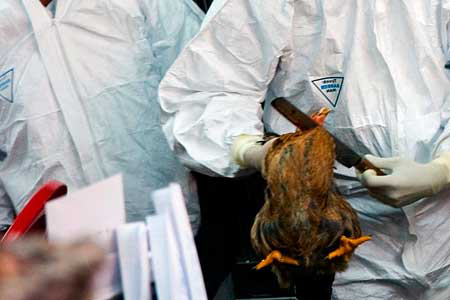UK study identifies way to contain bird flu outbreaks

Researchers at the University of East Anglia (UEA) in England have identified a rapid response which could help halt infectious diseases such as bird flu, swine flu and SARS before they take hold.
Focusing on the avian flu virus strain H5N1, research published in the journal PLOS ONE identifies key stages in the poultry trade chain which lead to its transmission to other birds, animals and humans.
High risk times for the disease to spread include during transportation, slaughter, preparation and consumption. It is hoped that the findings and recommendations will help stop the spread of other infectious diseases.
The H5N1 avian flu strain has been responsible for the deaths of millions of poultry, as well as 375 confirmed human deaths. Areas of Southeast Asia have been hardest hit with more than 2,500 reported outbreaks among domestic poultry in Vietnam alone. The disease has also spread rapidly from Southeast Asia into Europe. However the way that the virus transmits from poultry to humans has been poorly understood.
The UEA research team adopted a system widely used in the food production industry, known as Hazard Analysis of Critical Control Points (HACCP), and investigated whether it could be used as a rapid response to emerging outbreaks.
They investigated Vietnam’s poultry trade system and identified four key stages within the poultry trade chain which pose high risks for the transmission of HPAI viruses in human and poultry populations:
– Contact within poultry flocks which act as viral ‘mixing pots’. Examples include at markets which act as huge reservoirs for the virus, at bird vaccination centres, and at cock fighting contests.
– Transportation and sale of poultry and eggs.
– Purchase and slaughter of poultry from markets.
– Preparation of poultry for consumption – particularly in unhygienic conditions and when meat is raw or undercooked.
Preventative measures outlined in the report include isolating and quarantining flocks, using protective equipment such as masks, gloves and sterile utensils when slaughtering and preparing carcases for consumption, and using social media to promote good hygiene standards.
Dr Diana Bell who led the research said: “Since 1980 an average of one new infectious disease emerges in humans every eight months – representing a substantial global threat to human health.
“Diseases which originate in birds and mammals such as SARS and bird flu represent 60% of outbreaks. As well as representing a significant global health threat, they also create a burden to public health systems and the global economy.
“We identified poultry transportation, slaughter, preparation and consumption as critical control points in response to HPAI H5N1 outbreaks in Vietnam.”
The research was conducted as part of a three year interdisciplinary study of the impact of H5N1 on mechanisms of transmission, local livelihoods and food security. It was funded by the Economic and Social Research Council (ESRC) and the Natural Environment Research Council (NERC).













